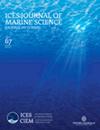Biennial patterns in Alaskan sockeye salmon ocean growth are associated with pink salmon abundance in the Gulf of Alaska and the Bering Sea
IF 3.4
2区 农林科学
Q1 FISHERIES
引用次数: 0
Abstract
In response to ocean heating and hatchery production, pink salmon (Oncorhynchus gorbuscha) returning from the North Pacific Ocean steadily increased after 1975, leading to concerns about their influence on food webs and competition with other species. Using measurements of distance between scale annuli of 24 584 individual sockeye salmon (O. nerka), we examined growth during their 2 or 3 years at sea from 1977 to 2015 for eight populations in Alaska. We found significant, negative autocorrelations at 1 lag year in annual growth of sockeye salmon, with a consistent pattern of lower growth in odd years, i.e. opposite to the biennial pattern of pink salmon abundance. Peak pink salmon abundances reduced growth of sockeye salmon from 7 to 14% during the second year in the ocean compared with growth when pink salmon abundance was low, while third-year growth was reduced up to 17%. The overall effect of pink salmon abundance on sockeye growth was over two times greater than the effect of sockeye salmon abundance. Production hatcheries and ocean heating contribute to the competitive dominance of pink salmon, underscoring the need to consider this unintended anthropogenic effect on the growth and productivity of sockeye salmon throughout the North Pacific.阿拉斯加红鲑海洋生长的双年度模式与阿拉斯加湾和白令海的粉鲑丰量有关
为了应对海洋升温和孵化生产,从北太平洋返回的粉红鲑(Oncorhynchus gorbuscha)数量在 1975 年后稳步增加,这引起了人们对其对食物网的影响以及与其他物种竞争的担忧。通过测量 24 584 条红鲑鱼(O. nerka)个体的鳞环之间的距离,我们考察了阿拉斯加 8 个种群从 1977 年到 2015 年在海上 2 或 3 年的生长情况。我们发现,红鲑的年生长量在滞后一年出现了明显的负自相关性,奇数年的生长量较低,这与粉鲑的双年丰度模式相反。与粉红鲑丰度较低时的生长量相比,粉红鲑丰度达到峰值时,红鲑第二年在海洋中的生长量减少了 7% 至 14%,而第三年的生长量则减少了 17%。粉鲑丰量对红鲑生长的总体影响是红鲑丰量影响的两倍多。生产孵化场和海洋加热导致粉鲑在竞争中占优势,这突出表明有必要考虑这种对整个北太平洋红鲑生长和生产力的意外人为影响。
本文章由计算机程序翻译,如有差异,请以英文原文为准。
求助全文
约1分钟内获得全文
求助全文
来源期刊

ICES Journal of Marine Science
农林科学-海洋学
CiteScore
6.60
自引率
12.10%
发文量
207
审稿时长
6-16 weeks
期刊介绍:
The ICES Journal of Marine Science publishes original articles, opinion essays (“Food for Thought”), visions for the future (“Quo Vadimus”), and critical reviews that contribute to our scientific understanding of marine systems and the impact of human activities on them. The Journal also serves as a foundation for scientific advice across the broad spectrum of management and conservation issues related to the marine environment. Oceanography (e.g. productivity-determining processes), marine habitats, living resources, and related topics constitute the key elements of papers considered for publication. This includes economic, social, and public administration studies to the extent that they are directly related to management of the seas and are of general interest to marine scientists. Integrated studies that bridge gaps between traditional disciplines are particularly welcome.
 求助内容:
求助内容: 应助结果提醒方式:
应助结果提醒方式:


